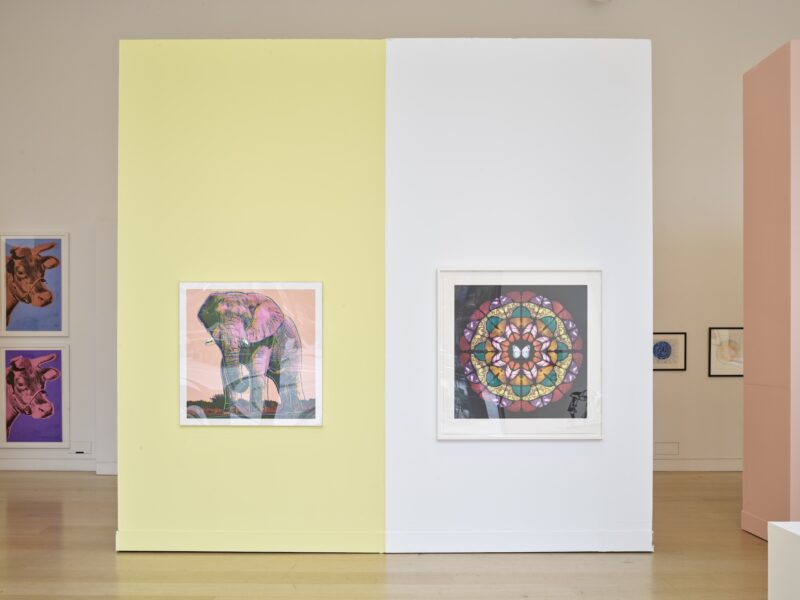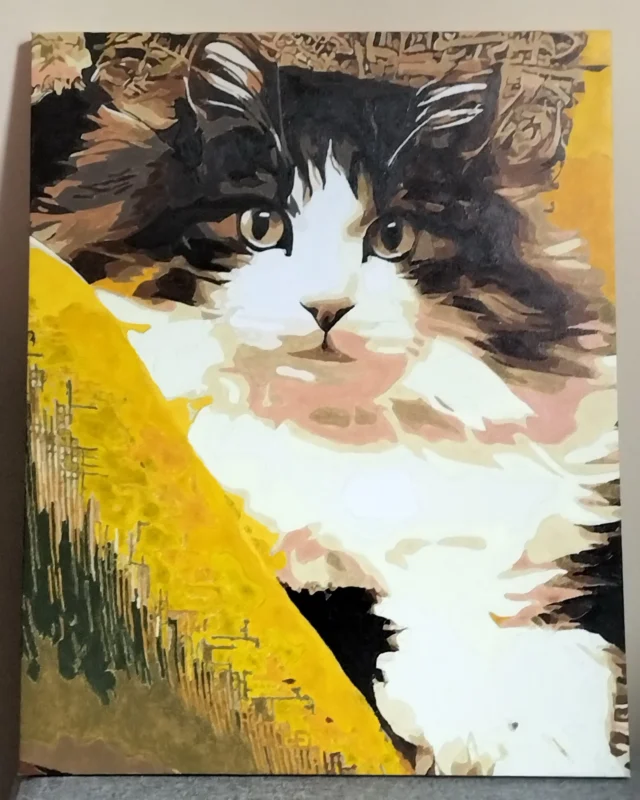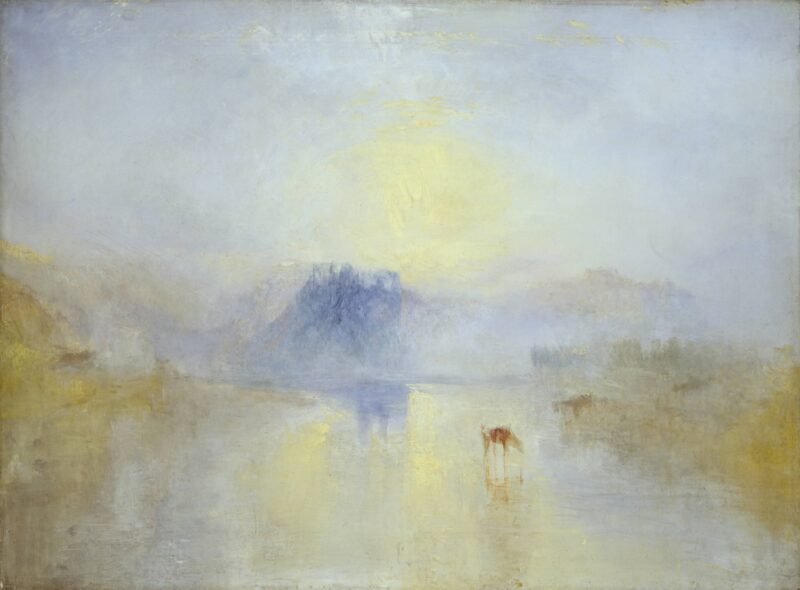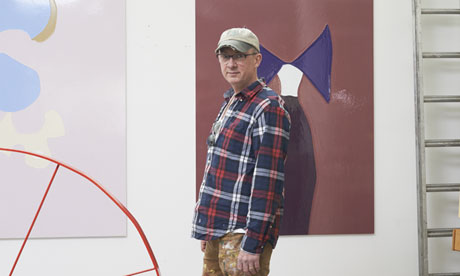
Gary Hume in his studio in east London: ‘You wouldn’t want to be here when I’m working.’ Photograph: Suki Dhanda for the Observer
The basement floor of Gary Hume‘s expansive east London studio is a large, bright square room full of creative mess and clutter. There are shelves packed with tins of gloss paint, a table covered in plastic containers of the same, and another long table inches deep in discarded pieces of drawing paper and pages torn from magazines. In the centre of the room stand three sculptures: big, thin, wonky, metal wheels, coated in resin and painted in bright colours, which look like they might topple over at any moment. The only things that are pristine and ordered are the dozen or so new paintings hung in a long, neat line around two walls, colours restrained, lines minimal, their aura inordinately calm.
“That’s because they’re finished,” says Hume, a soft-spoken man in paint-splattered workwear, who wears the permanent expression of someone rudely awoken from a nap who has not yet quite gathered his thoughts. “You really wouldn’t want to be here when I am still making them,” he says, smiling ruefully. “Then, it’s all loud music, sweat and swearing. ‘Fuck you! Fuck that, you total piece of shit!’ The finished paintings may be calm but the process is anything but.”
It’s a relief to hear this. Hume has a reputation for restraint rather than excess, for steady endeavour rather than tumultuous creativity. He is generally regarded as the quiet man of the YBA generation, though it may be that he just isn’t as loud as some of the others. In 2001 he was the first of that generation to be to be elected to the Royal Academy of Arts. Back in the late 1980s and early 1990s he eschewed the shock tactics, confrontation and sensationalism of his more famous peers – Damien, Tracey, the Chapmans – for a more measured approach that respected rather then trampled all over the traditional. A minimalist by temperament if not design, his flat, glossy paintings ran counter to the generational thrust towards grandstanding conceptualism. This restraint has stood him in good stead ever since as the youthful bravura of some of his better-known contemporaries has congealed into somethingempty and cliched.
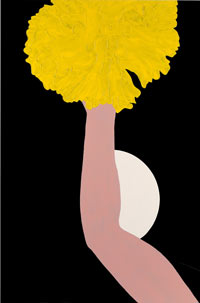
An artist’s artist, Hume is about to have a survey show at Tate Britain alongside the older painter, Patrick Caulfield, with whom he shares a formal affinity if only in their shared fondness for flatness rather than perspective. Hume will show just 24 paintings from 20 years of work, one of which – a nod to his breakthrough series of door paintings from 1988 – will be a painted on to the actual doors into the gallery. There are some surprising omissions, though, including his beautifully empty celebrity portraits of Kate Moss, Patsy Kensit and Michael Jackson, which are signature paintings of a sort. This says something about Hume’s single-mindedness and quiet, almost contrary self-assurance. “I chose not to put them in,” he says, shrugging. “I’ve got three rooms at the Tate so I can’t really do the big mid-life retrospective. I would have liked six rooms, then I probably would have done just that, but as it is I’ve chosen by instinct. My wife, Georgie [Hopton, also an artist], usually helps me but she was so busy with her own work that I had to do it myself. I didn’t want a greatest hits show either so I just went for interesting paintings.”
What, for him, constitutes an interesting painting? I would have assumed they were all interesting or else he would have binned them. He thinks about this for some time. “Well, a painting should be tough, it should have muscle, but I have to find some tenderness in it too. There has to be that dynamic.”
I wonder, as we peruse the catalogue for his Tate Britain show, whether the selection really shows off his range and his development as an artist? “Not really,” he says, matter-of-factly. “If anything, the paintings I chose have more to do with my memory of making them. The problems they presented to me. In that way, they show that I am actually a picture maker. It’s important to me that people see that.” He pauses for a moment, looking slightly pained. “People constantly describe me as a formalist or even a minimalist, but I’m not really bothered with the rules of painting or the history of painting. My approach is that everything is mine. I take what I can use from wherever and then I forget where I’ve taken it from. But there is no point me making anything that looks like anyone else’s. There is no point in a painting like that existing.”
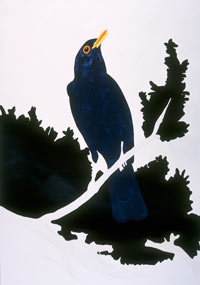
As is often the case with the quiet ones, Hume is both ambitious and driven. Though he is not in the silly-money league of Hirst or Jeff Koons, his paintings fetch upwards of £250,000 at auction, which means he can now divide his time between his house in London and his farm in upstate New York, which he and his wife are travelling to the following day so that they can tend to their vegetable garden. He has long been represented by Jay Jopling at White Cube. “Jay does his job incredibly well,” says Hume. “His business is huge and his reach is huge. He runs a very large business and acts accordingly, whereas before he was getting a grand for something and spending 900 quid on the party. It’s 1,000 miles from when we first knew each other.”
When they first met, Hume was one of the then unknown young artists in Damien Hirst’s now legendary Freeze exhibition in a disused warehouse in London Docklands in 1988. Hume showed his door paintings, which were inspired by a Bupa billboard he saw criticising the NHS, and were based on actual ward doors he measured in Barts hospital, east London, then reproduced life-size in gloss on aluminium. Big, red, shiny and flat, they were, he says, a kind of epiphany. “A door is such a paradoxical and generous object. Nothing is more blank and empty. Or more full.”
Before the doors, he says, he was just “muddling along, trying to find my way as an artist”. Born in 1962, Hume grew up in solidly middle-class Tenterden in Kent, fourth of five siblings. His father was a bit of a rogue who went awol when he was just a baby and his mother worked as an NHS surgery manager to support the family. She loved poetry and put art prints on the wall but he insists that his upbringing engendered no artistic ambitions. They came later out of necessity. “My desire to be an artist really came out of being broke and unemployed and incapable of holding a job down. That’s what it was driven by for sure.”
A quietly rebellious teenager, Hume left school at 16 with no qualifications and his route to art school was circuitous and dogged. He did odd jobs, including a stint as an assistant film editor in Soho, before studying life drawing at an adult education college in Camden. Then he spent two years doing art at a technical college in London because his lack of qualifications made him ineligible for a foundation course. A one-year stint followed at Liverpool Polytechnic. Unsettled by being out of London, he transferred to Goldsmiths to finish his degree, telling the administration he had to move back for personal reasons. (He was by then already the father of a young son, now 25 and “trying to make it as a photographer in Brooklyn”.)
It was a fortuitous move. At Goldsmiths Hume met a bunch of young artists with attitude that included Hirst, Mat Collishaw and Sarah Lucas, who was Hume’s girlfriend for seven years. He later described her as “a live wire”. When I ask her what he was like back then, she says: “When he first arrived at Goldsmiths in the second year he was coming into a place that was already very cool and self-conscious. He was easily the least self-conscious person there. He started working away in his studio oblivious to what anyone else was doing. I remember seeing these exploding glass panels of blood, and thinking, ‘Well, he’s a relief.'”
Hume shakes his head and grimaces when I ask him to recall the work he was making then. “It was all loaded with meaning and signifiers and shamanistic moves and God knows what. I was doing what young artists do, which is doing absolutely everything to try and find a style. It was fantastic to make and quite thrilling but none of it was ever mine.”
The door paintings changed all that. Blank but loaded, their shiny, flat surfaces caught the eye of contemporary art tastemakers, including an impressed Charles Saatchi, who descended on Freeze with his magpie eye for the new and the zeitgeisty and bought all of them. The fact that they were painted in household gloss on MDF and aluminium was a big talking point at the time, and one that suggested postmodern novelty. But, in fact, Hume had happened on his style and signature. “I have never been keen on making anything that reflects me in any way,” he explains. “I don’t want the author to be present. And the door paintings freed me from narrative, which is just not my thing. I’m not interested in my story one little bit.”
Has he thought about why this might be? Is it more than simply a Warholian fascination with the surface of things? “It probably comes from a desire to feel something rather that say it. Plus, I do have a certain intellectual anxiety that the story I would tell would be too dull. I couldn’t trust it to be interesting enough. I prefer to make something much stiller and emptier, where everybody disappears in it. I disappear, the viewer disappears, you don’t know what is going on. I don’t really want to know what I’m looking at.”
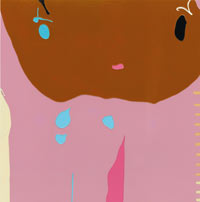
This perhaps gets to the nub of the problem that some critics have with Gary Hume’s work. Brian Sewell, enemy of conceptualism and all things contemporary, once wrote, “They offer nothing but a moment’s glister and demand no contemplation.” Hume has become inured to this kind of criticism and speaks confidently these days about the “stillness” and “calmness” he seeks in the finished works, and the huge amount of often complex-to-the-point-of-baffling thought that goes into them. The Tate Britain show includes his odd portrait of the DJ Tony Blackburn as a dark three-leaf clover, and another of German chancellor Angela Merkel as an expanse of green blankness with pale lips and a yellow chin. He says he has grown interested in Germany’s renewed economic and political power after its long period of post-war self-questioning and uncertainty, but it is difficult to extrapolate any of that from the almost abstract composition. I pick out a painting at random from the catalogue, an abstract landscape in shiny pink, blue and brown that could, at a push, be a face. It is called The Cradle. “That was me imagining me doing a children’s drawing of a child doing a self-portrait in its cradle,” he says, and you sense the kind of strange thought process that goes into every work.
Though he never had the public profile of many of his contemporaries, Hume remembers with fondness the mad, bad days of the YBA era. “There was a certain energy, even at the start when we were all poor and living in squats and freezing to death. A camaraderie. Some absolutely empty aspects of the whole thing were inflated by hype but those were also fantastic years, fantastic times.” As a painter he must have felt like the odd one out? “No. Not at all. They all liked my work. There was a mutual respect. I very much felt I was part of something, and making pictures within it.”
When the YBAs first began to go overground, Lucas remembers, Hume was “not that quiet at all. In fact, he had a slightly belligerent streak that came out when we first started hobnobbing with dealers and gallery owners. We thought of ourselves as on the other side of the fence back then so there was a certain amount of attitude flying about, and Gary would often put those people on the spot. It was all very entertaining.”
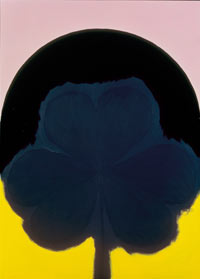
I ask Hume if he did the whole Groucho Club lost-weekend stuff with Damien and the rest. “Oh yeah, I partied with the best of them. It felt like the top of the world. I wasn’t at the top of the top of the world but I was in it, and I was self-confident, and it was exciting.” Did the partying ever get in the way of the painting? “Well, I was drinking too much at one point, yeah. The hangovers got bigger and longer. It was all incremental and you didn’t even notice it happening. Then you’d suddenly realise you’ve been drunk for four days. Mad times, really, but brilliant.”
As Sarah Lucas acknowledges, “it suddenly seems like a long time ago”.
I wonder if Hume still keeps in touch with the YBA crew? “From a distance. I still feel part of my generation but we’ve grown older and we’re all busy with our own work. I don’t see Damien socially because he has gone somewhere else. He hangs out with different people. Rich people, I guess. I still see Sarah from time to time but life goes on. I’m in London making work, and she’s in Suffolk making work. It’s just time passing.” He pauses for a moment, suddenly reflective. “I do think you get lonelier and lonelier being an artist as you get older.”
And richer too. At least if you are among the lucky few. Hume speaks with some feeling about the many artists of his generation he knows who are “still making work as they approach their 50s and still struggling to survive”. Does he ever think that having a lot of money affects the way he makes art? “It hugely affects it in one way,” he replies without hesitation, “because it gives you the absolute freedom to make work every day without distraction or worry.”
But does it take away the edge, the sense of being an outsider, a bohemian, a misfit? (Even as I ask this, I hear it sounding hopelessly, romantically old-fashioned, but…) He eyes me a little suspiciously, then marshals his thoughts. “Some artists do make money their driving force,” he says, refusing to be more specific, “because it’s how they define their own success. And I can see why that is because, as an artist, you do your best to make the best work you can but you can’t be sure that it’s any good, you can only hope it. So whenever someone hands over hard cash there’s a sensation of reward. And relief.”
Is that still the case now that he is established and financially secure? “If my paintings don’t make their prices at auction, I do find it is very depressing. I start thinking that I’m in decline in terms of my cultural relevance. It only lasts for about half a day but it affects you.”
We talk about the huge cultural sea change of recent years, in which it seems like art – and even popular culture – are increasingly becoming gentrified zones of exclusion. “I do sometimes look around Hoxton and think London is becoming like Manhattan,” he says. “The young, struggling artists will have to leave as prices get more and more prohibitive. There was a disenfranchisement among my generation that made the YBA thing possible but it seems somehow different now. I get the sensation that art school is another career choice now for respectable, responsible students aiming to make lots of money. You do wonder, what will all the wrong people do? Will they just take drugs for a while, then disappear?”
We walk around his studio and look at his new paintings, all made for a forthcoming show in New York. They seem more abstract and complex in their arrangement of lines and colours, so much so that I have to ask him more than once what it is exactly that I am looking at. A big arrangement of circles and squares turns out to be a sniper in close up. Another the shirt and tie of an American chief of police. The series was inspired, he tells me, by a magazine he bought at a deli counter in New York, commemorating the death of Osama Bin Laden. He roots through a pile of papers and uncovers it: a one-off publication called United We Stand. There are pictures of firefighters, policemen, soldiers and members of the public, some grinning and holding up placards celebrating Bin Laden’s execution.
“People ask me where I find the starting point for my paintings,” he says, grinning, “Well, here is this overwhelming historical moment that is so rich with possibility and I found it right there at the checkout counter along with the Snickers bars and Hello! magazine. You just have to be open to stuff all the time as an artist.”
In his own flat, glossy, beautifully empty way, then, Gary Hume is very much a painter of everyday life in all its rich and limitless strangeness.
Gary Hume runs from 5 June to 1 Sept at Tate Britain, London SW1, with a single ticket also covering the Patrick Caulfield exhibition. Members of Extra, the Guardian and Observer membership service, can win one of 100 pairs of tickets to a readers’ private view of both exhibitions on Monday 17 June. Join Extra at guardian.co.uk/extra
guardian.co.uk © Guardian News & Media Limited 2010
Published via the Guardian News Feed plugin for WordPress.
